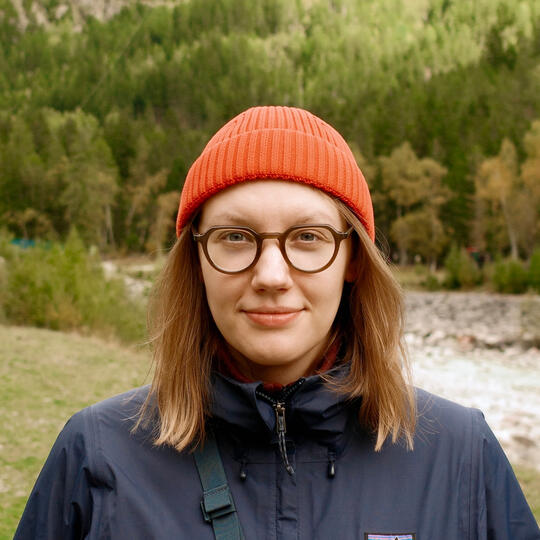
Dr. Kasia Dutkowska
IPA: /'kaʃa du'tkɔfska/
Astrophysicist | Postdoctoral Researcher at Leiden Observatory
Astrochemistry ・Star Formation ・ ISM & Chemical Modeling ・Feedback
Hi, I’m Kasia
I’m an astrochemist, which means that in my work I use molecules as messengers, revealing the physical and chemical conditions and histories of different cosmic environments. I am especially drawn to chaotic, extreme regions like the Galactic Center of the Milky Way or distant galaxies with active galactic nuclei and intense star formation.Current work
I’m a postdoctoral researcher at Leiden Observatory in Prof. Serena Viti’s group, where I am one of the developers and maintainers of UCLCHEM, a time-dependent gas-grain chemical code. Lately, I’ve been focused on the Milky Way’s Central Molecular Zone, a turbulent, molecule-rich region that constantly challenges our understanding of interstellar chemistry.A step back → PhD work
During my PhD, I built “galaxy-in-a-box”, a Python-based model that predicts molecular emissions from active star formation in galaxies. Ultimately, I wanted to explore the era when the Universe formed most of its stars (Cosmic Noon, ~10–11 billion years ago), understand how star formation contributes to galactic emission, and see if we could identify new tracers of these processes. The project bridges theory and observations without relying on heavy simulations, offering a more direct way to interpret molecular feedback. The project is currently on hold, with further development planned.A bit more about me
Before I found myself in astrophysics, I studied filmmaking in London, dreaming of becoming a director. That path didn’t quite fit, but it shaped how I approach problems creatively and notice patterns others might miss. Science eventually pulled me in, and I ended up earning a PhD in astrophysics from the University of Copenhagen. As a first-generation academic, it was a leap, but one I’m glad I took.Creativity remains part of my life. I am an active street photographer, with work featured by Samsung, Polaroid, the Danish Architecture Centre, BuzzFeed. I’m also super into curating music playlists (I know it sounds cheesy, but since I’ve never become a DJ, this is my compromise) and maybe one day I’ll host a show on an independent online radio. Beyond the arts, I’m a huge mindfulness and mental health advocate. And last but not least, I’m a coffee nerd - the funkier, the better - but I don’t judge anyone else’s cup.
Publications
Please note: I did not list all co-authored in prep. or submitted papers. For the full list of the under review/submitted/in preparation papers please contact me.FIRST AUTHOR
The curious case of HCO⁺: extreme abundances under extreme condtions
Dutkowska, K.M., Jia, B., Viti, S., et al.
In preparation (soon to be submitted)Chemical templates of the Central Molecular Zone. Shock and protostellar object signatures under Galactic Center conditions
Dutkowska, K.M., Vermariën, G., Viti, S., et al. 2025
Astronomy & Astrophysics, Volume 703, A46Star-formation-rate estimates from water emission
Dutkowska, K.M. & Kristensen, L.E. 2023
Astronomy & Astrophysics, Volume 674, A95Water emission tracing active star formation from the Milky Way to high-z galaxies
Dutkowska, K.M. & Kristensen, L.E. 2022
Astronomy & Astrophysics, Volume 667, A135CO-AUTHORA novel one-dimensional and time-dependent model for complex
organic molecules in molecular cores
Tram, L. N., Viti, S., Dutkowska, K.M., et al. 2025
Soon to be acceptedCircumnuclear eccentric gas flow in the Galactic Center revealed by ALMA CMZ Exploration Survey (ACES)
Sofue, Y., et al. (incl. Dutkowska, K.M.) 2025
Publications of the Astronomical Society of Japan, psaf072The Galactic Center arms inferred from the ALMA CMZ Exploration Survey (ACES)
Sofue, Y., et al. (incl. Dutkowska, K.M.) 2025
Publications of the Astronomical Society of Japan, psaf034A Broad Line-width, Compact, Millimeter-bright Molecular Emission Line Source near the Galactic Center1
Ginsburg, et al. (incl. Dutkowska, K.M.) 2024
The Astrophysical Journal Letters, Volume 968, Issue 1, L11
OTHER
The Leiden/ESA Astrophysics Program for Summer Students (LEAPS)
Bellotti S., Sellek A., Sharda, P., Dutkowska K.M., Chrimes A., and Röttgering H. 2025
Under review
1The article was chosen for a Research highlight in Nature:
An object in space is emitting microwaves — and baffling scientists
Nature, Volume 630, 533 (2024)
This section is still being developed.Mediocrity's easy, the good things take time, the great need commitment.
~ (presumably) Bob Seger
All personal information is limited to publicly available professional data.